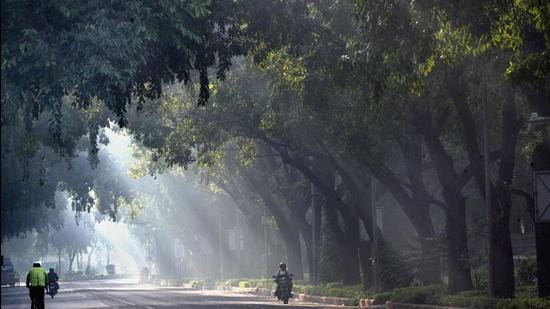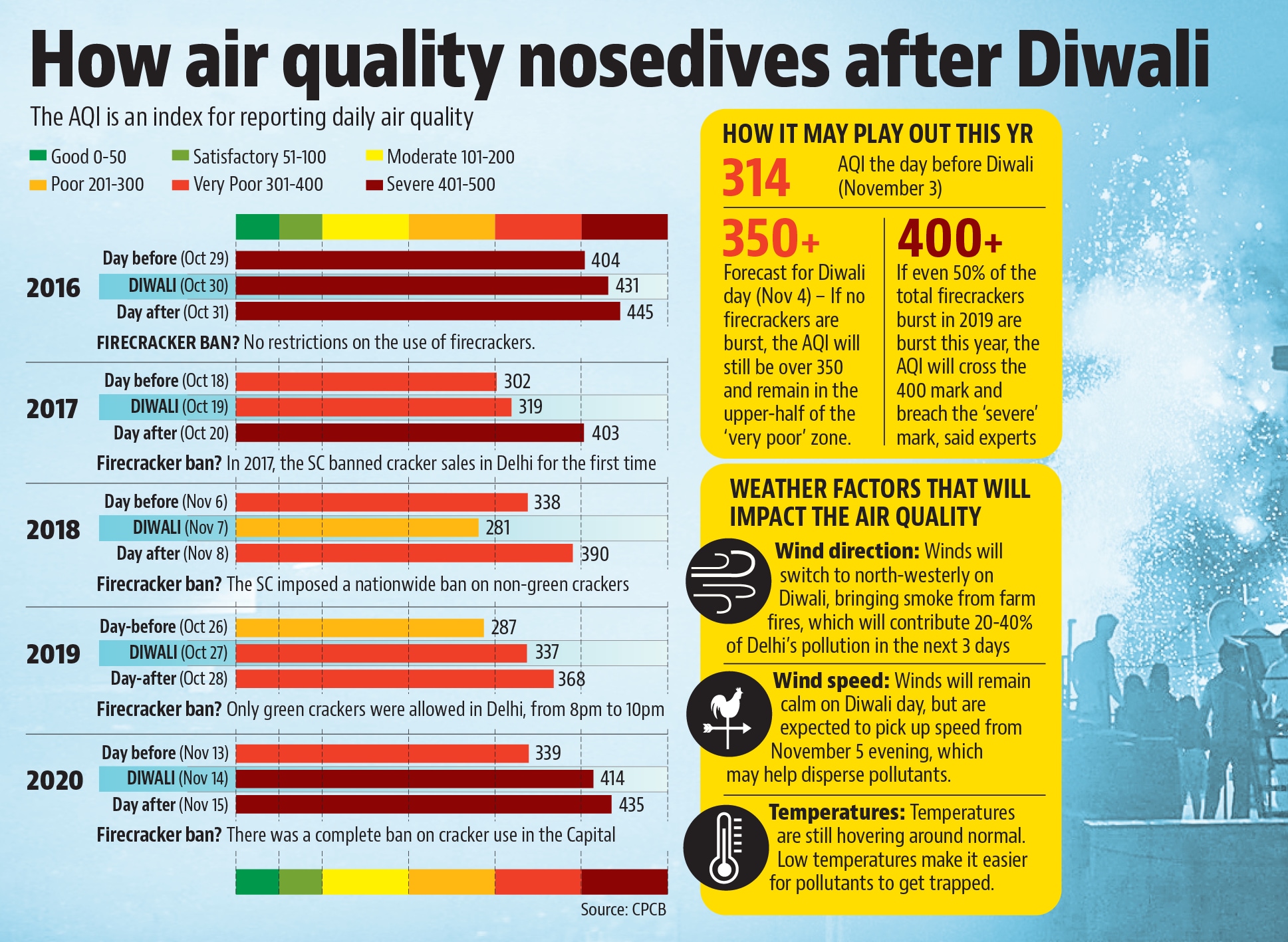Crackers or not, air quality in Delhi likely to continue downward slide: IMD
According to India Meteorological Department (IMD), from Thursday, the wind direction will change to northwesterly which will bring more particulate pollutants from the farm fires in Punjab and Haryana.
Slow winds, a change in the wind direction, drop in temperatures and high humidity -- weather conditions conducive for slow dispersal of pollutants -- will ensure very poor air quality in Delhi on the occasion of Diwali on Thursday even if people do not burst firecrackers, weather scientists have said.

According to India Meteorological Department (IMD), from Thursday, the wind direction will change to northwesterly which will bring more particulate pollutants from the farm fires in Punjab and Haryana. On Wednesday, the overall contribution of a total of 3,271 stubble fires to the pollution in Delhi was recorded at 8%. According to System of Air Quality and Weather Forecasting and Research (Safar), a forecasting body under the Union ministry of earth science, this contribution may go up to 40% on Thursday.
RK Jenamani, scientist at IMD, said temperatures are currently staying near normal, and will remain in the same range for the next few days, but calm wind conditions are expected on both November 4 and 5. There will be high humidity too.

Jenamani, however, predicted that things may improve Friday night onwards. “Relief is likely only from the night of November 5 and the morning of November 6 onwards. Wind speeds will pick up and touch 30 km/hr and help disperse pollutants,” Jenamani said.
On Wednesday, ahead of Diwali, a meeting of the sub-committee on the Graded Response Action Plan (Grap) was also held during the day, with experts warning of air quality deteriorating to the higher end of the ‘very poor’ category between November 4 and 6. However, no fresh directions were issued.
Tanushree Ganguly, programme lead at the Council on Energy, Environment and Water (CEEW), said forecasts by Safar, Urban emissions and Delhi’s new air quality decision support system (developed by IITM) all suggest air quality will be in the higher end of the ‘very poor’ category on Diwali, even if crackers were not used.
“If people burst firecrackers, we may see ‘severe’ air -- levels of air pollution which especially impact the health of children, elderly, and those with existing health problems. Delhi’s forecasting systems have a clear message for all of us. If we want to protect the health of our family and neighbours, we must refrain from using firecrackers,” said Ganguly.
According to the Central Pollution Control Board (CPCB) data, air quality in Delhi last month remained uncharacteristically decent till October 26. However, from October 27, the air quality stayed in the poor zone till November 1. On November 2, the city recorded AQI in the very poor zone for the first time since the last 146 days. On November 3, the air stayed in the same zone, indicating it may worsen further.
To be sure, the Delhi government has imposed a complete ban on sale, storage and use of firecrackers with teams being formed to ensure that people do not violate the rules on Diwali.
On the eve of Diwali on Wednesday, Delhi environment minister Gopal Rai urged the citizens to shun firecrackers, asked political parties not to link cracker bursting with religious traditions and appealed to the Centre to issue and advisory to the neighbouring states of Punjab, Haryana and Uttar Pradesh to stop stubble burning.
Polluted Diwali, a norm
CPCB data shows Delhi recorded its most polluted Diwali day in 2016, when the AQI touched 431 (severe) on October 31. In 2020, despite a complete ban on firecrackers, an AQI of 414 (severe) on Diwali day made it the second most polluted Diwali in the last six years. Last year, Diwali was celebrated on November 14.
Around the festival, the impact of smoke from farm stubble burning is usually at its peak, the effect of which is amplified by the low temperatures and emissions from firecrackers.
Over the last two years, weather has come to Delhi’s rescue during Diwali. While pollution levels have spiked on Diwali night and the day after, strong winds and rain have helped disperse the cracker smoke.
In 2020, despite recording the worst pollution spike on and post-Diwali because of an increase in cracker bursting, heavy rain and strong winds the day after, helped clear the pollution levels in the city. On November 14, Diwali day, the AQI hit 414. A day later, it increased further to 435. But by November 17, the AQI had improved to 171.
“A western disturbance crossed the national capital on Diwali night last year, which led to an increase in the wind speeds. Though the impact was not seen immediately in the next day’s data because it is a 24-hour average, the AQI in the next few days reached the moderate level,” a senior Met official said.
In 2019 too, high wind speeds helped disperse the cracker emissions quicker than it had in 2018, environment experts pointed out. That year, Diwali was celebrated on October 27.
“The dispersion of pollutants was as fast as the build-up. This is because of the stronger winds compared to 2018 ,” an analysis by Centre for Science and Environment (CSE) that year said.
While there was a complete ban on firecrackers last year, only green crackers were allowed in 2018 and 2019 – with violations being reported in both years.
Stay updated with all top Cities including, Bengaluru, Delhi, Mumbai and more across India. Stay informed on the latest happenings in World News along with Delhi Election 2025 and Delhi Election Result 2025 Live, New Delhi Election Result Live, Kalkaji Election Result Live at Hindustan Times.
Stay updated with all top Cities including, Bengaluru, Delhi, Mumbai and more across India. Stay informed on the latest happenings in World News along with Delhi Election 2025 and Delhi Election Result 2025 Live, New Delhi Election Result Live, Kalkaji Election Result Live at Hindustan Times.





